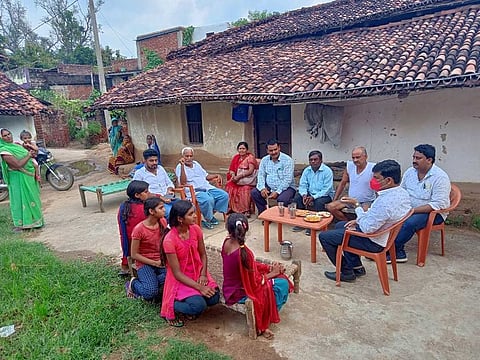Jharkhand villagers to name houses after daughters to fight gender discrimination
Move a result of campaign by administration to highlight the role of girls in society

Patna: Villagers in India’s eastern Jharkhand state have decided to name their houses after daughters as a mark of respect to the girl child and end gender discrimination in society.
The move has earned praise from various quarters. The mineral-rich state that was carved out of Bihar in November 2000 is dominated by tribal villagers.
As part of this initiative, residents from Bhartiya village in Jharkhand’s Garhawa district will be putting up plaques bearing the names of their daughters outside every home. A total of 113 families stay at the village, according to the 2011 census.
“My daughters are my pride,” a local villager Jitendra Sinha said, adding the move would convey the right message and more villages would come forward to give girls the respect they deserve.
The move is the result of a sustained campaign launched by the local administration to highlight the role of girls in society and work for women’s empowerment. The local administration headed by district education officer Sanjay Kumar kicked off this campaign after finding the sex ratio alarming in the region.
“The name plates carrying the names of girls will not only boost the confidence of women but will also create a positive image in society,” district education officer, Garhawa, Kumar said. Stating that the move will bring social revolution, the officer said the idea behind it was to ensure female members from the family get their identity in society.
“It’s a must to give women the kind of importance they deserve because they generally don’t have any independent identity of their own after they get married,” he said, adding that seeing their names on nameplates would give them a sense of belonging and pride. He said the initiative would go a long way towards women’s empowerment.
Social scientists said the move was bound to improve the sex ratio in society in general and the village in particular. According to the 2011 census data, the village has a sex ratio of only 740 females per 1,000 males against the state’s sex ratio of 948 females per 1,000 males.
Among children, in this village there are only 658 girls for 1,000 children. Apparently, this factor drew the attention of the local administration which was compelled to launch a campaign for social change.
Local village council chief Bindu Devi said she was conducting a survey of the village with the help of the teachers to get the names of daughters and their mothers so that the names could be displayed at the entry points of the houses soon. The survey will be completed within three days.
Sign up for the Daily Briefing
Get the latest news and updates straight to your inbox





![Authorities probe accidental or illegal use of explosives. [Illustrative image]](http://media.assettype.com/gulfnews%2Fimport%2F2023%2F02%2F04%2FIowa-woman-declared-dead-found-alive-gasping-for-air-in-a-body-bag_1861b6fe837_large.jpg?w=320&auto=format%2Ccompress&fit=max)
![Licensed rifle discharged while children were playing. [Illustrative image]](http://media.assettype.com/gulfnews%2F2025-12-27%2Fbo5oadv9%2Fpolice.jpg?w=320&auto=format%2Ccompress&fit=max)